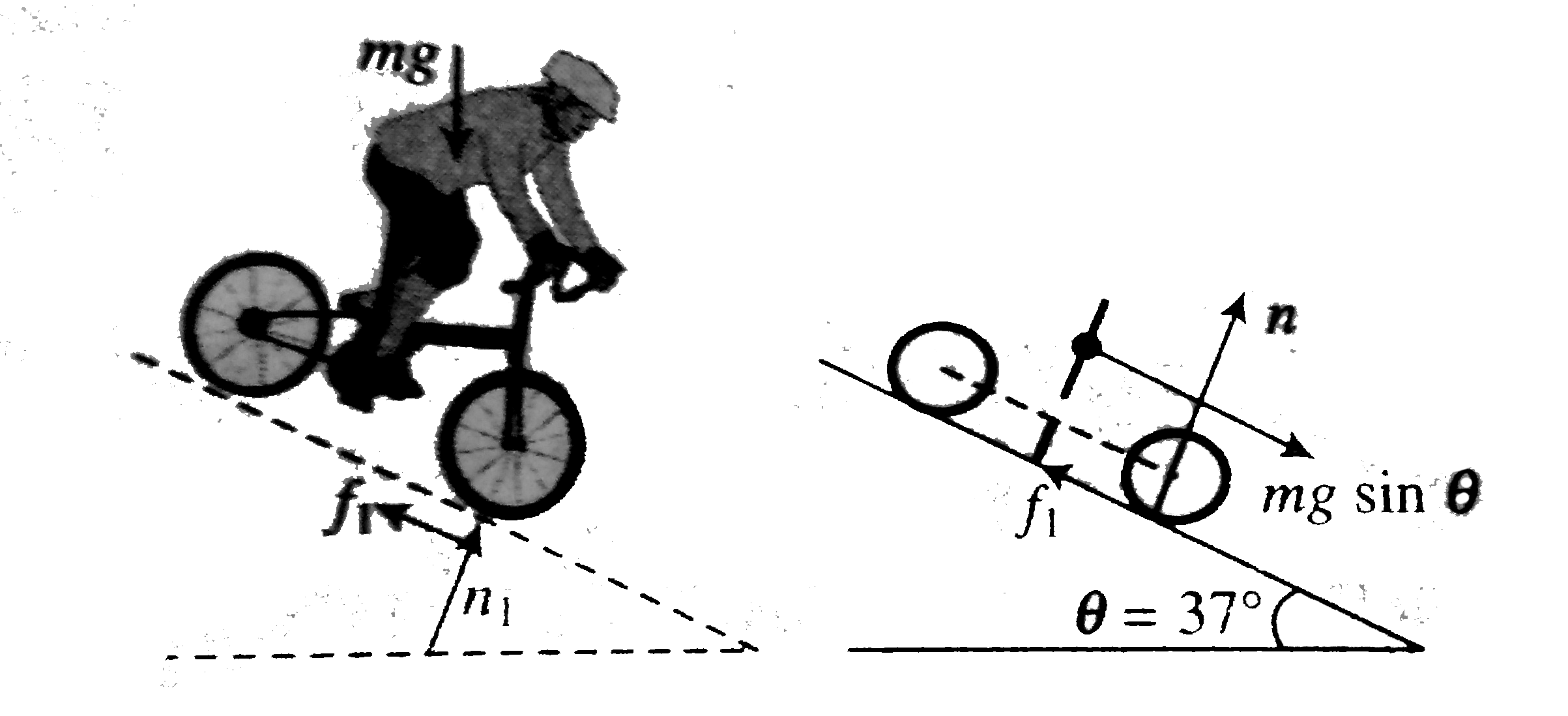A bicycle is traveling downhill at a high speed. Suddenly, the cyclist sees that a bridge ahead has collapsed, so she has to stop. What is the maximum magnitude of acceleration the bicycle can have if it is not to flip over its front wheel—in particular, if its rear wheel is not to leave the ground? The slope makes an angle of 37∘ with the horizontal. On level ground, the centre of mass of the woman–bicycle system is at a point 1.0m above the ground, 1.0m horizontally behind the axle of the front wheel, and 35.0 cm in front of the rear axle. Assume that the tires do not skid.
For stoping the cyclist should retard i.e, acceleration should be in the direction up the sloping surface. When the cyclist is one the point of tipping over forward, the normal force on the rear wheel is zero. Parallel to the plane we have f1−mgsinθ=ma. Perpendicular to the plane n1−mgcosθ=0. Torque about the centre of mass

f1(1.0m)=n1(1.0m) or f1=n1
From above equation we get a=−2ms−2.
Topper's Solved these Questions
- BOOK - CENGAGE PHYSICSCHAPTER - RIGID BODY DYNAMICS 1EXERCISE - Exercise 2.411videos
RIGID BODY DYNAMICS 1
- BOOK - CENGAGE PHYSICSCHAPTER - RIGID BODY DYNAMICS 1EXERCISE - Subjective13videos
RIGID BODY DYNAMICS 1
- BOOK - CENGAGE PHYSICSCHAPTER - RIGID BODY DYNAMICS 1EXERCISE - Exercise 2.217videos
RIGID BODY DYNAMICS 1
- BOOK - CENGAGE PHYSICSCHAPTER - PROPERTIES OF SOLIDS AND FLUIDSEXERCISE - INTEGER_TYPE2videos
PROPERTIES OF SOLIDS AND FLUIDS
- BOOK - CENGAGE PHYSICSCHAPTER - RIGID BODY DYNAMICS 2EXERCISE - Interger2videos
RIGID BODY DYNAMICS 2
Similar Questions
What type of motion does the wheel of a bicycle have ?
View SolutionOn what principle does a bicycle work ? What is the mechanical advantage of a bicycle? Determine the velocity ratio of a bicycle in which the ratio of teeth on the rear sprocket wheel to that on the front wheel is 1: 3.
View Solution
Knowledge Check
- Question 1 - Select One
A bicycle is moving on a straight road at a constant speed. The wheels of the cycle exhibit :
ACircular, translational and periodic motionBCircular and translational motionCTranslational and periodic motionDCircular and periodic motion - Question 2 - Select One
A particle of mass m is projected with velocity making an angle of 45∘ with the horizontal When the particle lands on the level ground the magnitude of the change in its momentum will be .
A√2mvBZeroC2 mvDmv√2 - Question 3 - Select One
the radus if the rear wheel of bicycle is twice that of the front wheel. When the bicycle is moving . The angular speed of the rear wheel compared to that of the front is
AGreaterBsmallerCsameDexact double
Fill in the blanks
Motion of a wheel on a bicycle is _____ motionView SolutionFill in the blanks
Motion of a wheel on a bicycle is _____ motionView SolutionA bicycle is running straight towards north What is the locus of the centre of the front wheel of the bicycle whose diameter is d ?
View SolutionWhen a cicycle travels on a rough surface, its speed
View SolutionIn a bicycle the radius of rear wheel is twice the radius of front wheel. If vF and vr are the speeds of top most points of front and rear wheels respectively, then :
View Solution

